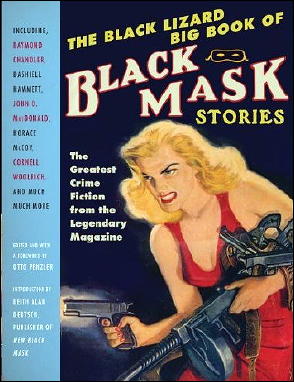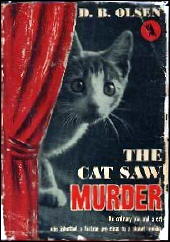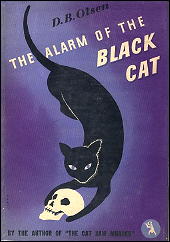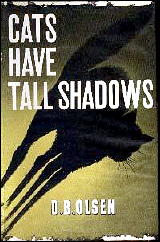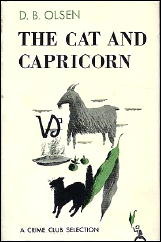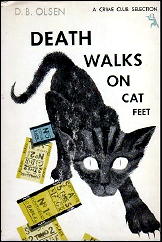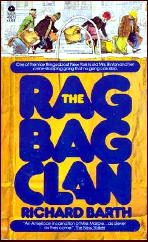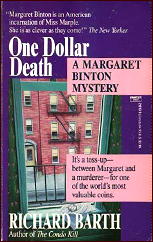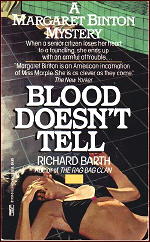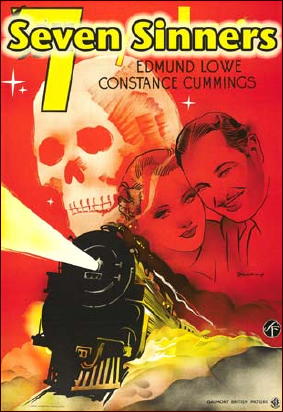September 2010
Monthly Archive
Sun 26 Sep 2010
COLLECTING PULPS: A MEMOIR
PART ONE — BLACK MASK
by Walker Martin
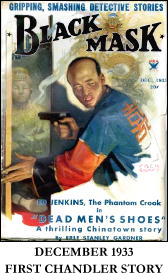
In the 1940’s an admirer of Raymond Chandler’s fiction wrote a letter asking Chandler if it was possible to obtain back issues of the magazines containing his stories. Chandler responded that it was just about impossible to find such back issues and he doubted if the correspondent would have any luck.
Jump ahead more than 20 years to 1968 and that was my attitude also. I had been a SF fan for over 10 years collecting the pulps and digests, attending the SF conventions and reading the fanzines.
Since I also was reading a lot of mainstream literature and mystery fiction, I was interested in back issue magazines that published fiction other than SF, but I was not finding the issues.
I figured the SF and hero pulps survived because of teen age boys and their drive to collect things. So I reasoned that the adults must have read and thrown away their copies of the adult pulps like Black Mask, Adventure, Dime Detective, Short Stories, etc.
However, in 1968 a life changing event occurred and I know we all laugh when we hear those words because often it is not really THAT “life changing”. But it was in my case and I never really realized the impact of simply buying one paperback until decades later when I was almost crushed by a collapsing, heavily loaded bookcase full of detective pulps.
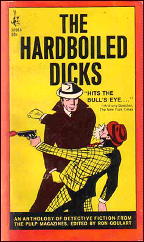
As I lay there too stunned to move, I began the process of thinking how had my reasonable SF collection turned into a massive amount of pulps, vintage paperbacks, books, etc.
The event I’m talking about is the mundane task of buying a book titled The Hardboiled Dicks, edited by Ron Goulart. It was a collection of crime stories from such pulps as Black Mask, Dime Detective, Detective Fiction Weekly. After reading the stories and Goulart’s editorial comments, I realized without a doubt, it was possible to collect the detective pulps and the genres such as western and adventure fiction.
I wrote Goulart and asked him if it was possible to buy his copies of the detective magazines that he had used for his research. I’m happy to say he wrote back and sold me all the copies he had for only a couple bucks each.
These few pulps that he sold me eventually caused me to accumulate complete sets of Black Mask and Dime Detective and an almost complete set of Detective Fiction Weekly, not to mention the other titles that I started to also collect. Almost 40 years later Ron Goulart wrote in my copy of The Hardboiled Dicks, “For Walker, whose life I ruined”.
“Whose life I ruined” just about sums up the thoughts and feelings of many non-collectors when they see a house full of books and old magazines. I could give dozens of examples but I’ll try and control myself and just mention one early story from 1969 involving collectors, non-collectors, and romance.
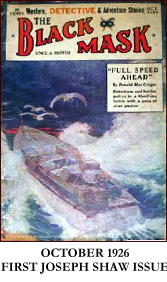
At the time I was busy writing hundreds of letters to collectors, book stores, etc. in an attempt to put together complete sets of Black Mask and the other detective magazines. This was pre-Pulpcon and the Internet did not exist, so everything was by regular slow mail.
The Collector’s Bookstore in California sent me a package of about a dozen Black Mask’s from the thirties. Needless to say I was checking my mail every day but the day they came I was at work and the package was returned to the main post office. I showed up early the next morning before work with the postal slip saying there had been a failed attempt to deliver.
The Trenton NJ post office was a massive structure and the postal clerk returned after a few minutes and told me he could not find the package. The next few minutes are still a blur in my memory, but let’s just say the head postal inspector was summoned and he tried to calm me down by saying there was nothing to worry about since the package was insured.
I imagine every fellow collector reading this knows my response along the lines of “I didn’t care about the insurance, the magazines were rare collectables and irreplaceable.”
After another long delay and search they found the stack of Black Mask’s with just some twine wrapped around them and no package left at all.
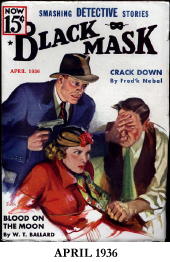
When I arrived at work I was completely frazzled and shaken. The employees I worked with could not understand why I was so upset about some old crumbly magazines.
After I regained control, I showed the stack to a girl I was interested in who had the desk behind me. I told her about the importance of Raymond Chandler and Dashiell Hammett and even asked her if she would like to read any of the magazines.
Her response of “no” was a deal breaker and the end of any possible romance. I never did have any luck in finding a woman who liked pulps.
So began my lonely occupation of collecting back issues. The great number of letters I was mailing resulted in many collectors across the country selling me Black Mask’s . Richard Minter, who was the greatest mail order pulp dealer who ever lived, was especially helpful.
At first he was surprised because all his customers were mainly SF and hero pulp collectors. He had no one interested in the detective magazines. But because of his extensive contacts among old time collectors, he started mailing me a steady stream of packages, all wrapped in brown paper with string and old stamps that someone must have paid him with.
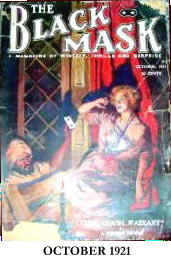
I know this is hard to believe but he was asking only 2 or 3 dollars per pulp. This was the average price I was paying and the set was almost completed except for a very few issues.
My main activity during 1969,1970, and 1971 revolved around finding back issues of Black Mask. I cared nothing for my work career, it was just a means to be able to collect. By the first Pulpcon in 1972 I had a complete set of the 340 issues except I was lacking one hard to find issue, October 1921. Some of the issues were in rough shape, and for many years I continued to upgrade.
At first, I had no real competition but as I started to rave to other collectors, my enthusiasm created the market and other people started to pick up issues. There was a fellow collector in Trenton who I kept talking to about how great the magazine was, and before I realized my stupidity, he was my main competitor.
We both eventually ended up with complete sets and as far as I know there were only a couple other extensive runs, including one at UCLA, but nothing complete.
At the end, in order to beat out the competition, I was sending dealers more than they asked for because I figured they would sell to me even if another collector beat me to the item. Many a time, someone would ask $5 for example and I send them double the amount, with my comment of “I feel the issue is worth more”. It always seemed to work.
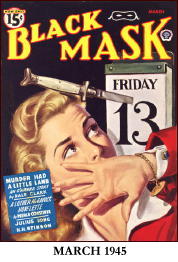
Concerning the October 1921 issue, there must have been something wrong with print run of that date or perhaps many copies were destroyed in some accident, etc.
I say this because out of 340 issues, 1920-1951, the two collectors with almost complete sets both needed this same issue. For many years I advertised and hunted for it and finally dealer Jack Deveny, at an early eighties Pulpcon, conducted a mini auction between me and several collectors. There was no way I was not going to get the issue and my sealed bid won at over $700. Back then, this was an unheard amount to pay.
Eventually, I tracked down three original Black Mask cover paintings, all from the 1940’s. One of them I managed to get from artist Raphael Desoto after a weekend of talking to him at an early book convention. I cried, I whined, I begged, etc. Nothing is too shameful among serious, out of control collectors.
I also manage to find a stack of canceled checks paying Black Mask writers and artists. When I bought them back in the 1970’s no one would even pay $1.00 each. Now they bring far higher amounts.
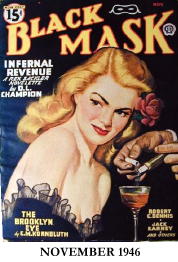
After Black Mask died in 1951, Ellery Queen Mystery Magazine bought the title and beginning with May 1953 issue had a section in each issue reprinting two stories from the magazine. Eventually they cut back to one story and even published new stories in the Black Mask tradition.
They soon added the subtitle “including Black Mask Magazine” on the contents page. This subtitled continued off and on through the fifties and sixties and I see it appearing even as late as the September, 1973 date.
I’ve done extensive reading in the magazine during almost four decades. The twenties are not that readable, except for Dashiell Hammett, Frederick Nebel, Raoul Whitfield and Erle Stanley Gardner. Some readers even like Carroll John Daly.
By the time Joe Shaw took over in late 1926, things began to improve and he encouraged the above writers. Most readers find the thirties the best and even some collectors present an argument for the 1940’s when Popular Publications took over with Ken White as the editor.
Behind Hammett and Chandler, I think Paul Cain was the best writer even though he was not that prolific, then Nebel, Whitfield, and Norbert Davis. The 1940’s are full of excellent writers like Merle Constiner, John D. Macdonald, Robert Reeves, D. L. Champion, Cornell Woolrich, William Campbell Gault, and others.
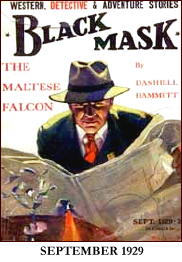
To collect the magazine nowadays would require a lot of money and I’m not even sure a set could be put together. Hammett and Chandler issues are expensive, going for hundreds of dollars each. I recently saw the 5 issue “Maltese Falcon” issues go for almost $4000 and I thought this price was too low.
Even without these two authors in the issue the 20’s and 30’s go for over one or two hundred, according to condition. The forties still are affordable with plenty of readable stories and it’s possible to find issues at the $25 to $50 price.
Fortunately for readers who want to sample the fiction there are several collections:
The Hard-Boiled Omnibus, edited by Joseph Shaw
The Hardboiled Dicks, edited by Ron Goulart
The Hard-Boiled Detective: Stories from Black Mask Magazine, edited by Herbert Ruhm
The Back Mask Boys, edited by William Nolan
The Black Lizard Big Books of Pulps edited by Otto Penzler (most of the stories).
The Black Lizard Big Book of Black Mask Stories, edited by Otto Penzler (over 50 stories!)
Thus ends my story of a 40 year love affair with a pulp. I can truthfully say I have only learned two things in life, “The non-collector will never understand the collector.” And “Never take the advice of a non-collector concerning your collection.”
These two things are absolutely true and you might ask why? Because the non-collector knows absolutely nothing about your collection and just sees it as so much clutter, waste of money, and a crazy waste of time. But we know different, don’t we.
COMING SOON: Part Two — Collecting Dime Detective.
Sat 25 Sep 2010
THE BACKWARD REVIEWER
William F. Deeck
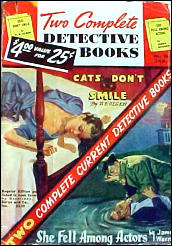
D. B. OLSEN [aka DOLORES HITCHENS] – Cats Don’t Smile. Doubleday Doran/Crime Club, hardcover, 1945. Later published in Two Complete Detective Books #36, pulp magazine, January 1946 (with She Fell Among Actors, by James Warren).
Rachel and Jennifer Murdock, whose exploits — if Jennifer can be said to engage in exploits — Olsen has chronicled before and after this novel, go to Sacramento, Calif., to house-sit for Cousin Julia, who for reasons she doesn’t explain must leave the house and does not want her roomers unsupervised.
Miss Rachel embroils herself in the roomers’ affairs and those of the next-door neighbors. Before she can meddle much, one of the roomers is murdered.
For those who enjoy Little-Old-Lady detectives, this should be a pleasing mystery, particularly if active LOL’s are preferred. For my part, I have always thought Jane Marple was the perfect type. Not for her the burglary at dead of night or skulking in gardens eluding who knows what.
Both interesting and unusual is the motive for murder. However, I had difficulty in accepting the solution, for reasons which I won’t go into since it would reveal the murderer’s identity.
Warning: Cat lovers may be upset by one of the incidents in the novel.
— From The MYSTERY FANcier, Vol. 11, No. 2, Spring 1989.
The Rachel & Jennifer Murdock series —
The Cat Saw Murder. 1939. [Doubleday Crime Club for all but one.]
The Alarm of the Black Cat, 1942.
Cat’s Claw. 1943.
Catspaw for Murder. 1943.
The Cat Wears a Noose. 1944.
Cats Don’t Smile. 1945.
Cats Don’t Need Coffins, 1946.
Cats Have Tall Shadows. Ziff-Davis, 1948
The Cat Wears a Mask. 1949.
Death Wears Cat’s Eyes. 1950.
The Cat and Capricorn. 1951.
The Cat Walk, 1953.
Death Walks on Cat Feet. 1956.
Sat 25 Sep 2010
THE ARMCHAIR REVIEWER
Allen J. Hubin
RICHARD BARTH – Deadly Climate. St. Martin’s, hardcover, 1988. Reprint paperback: Fawcett Crest, 1989.
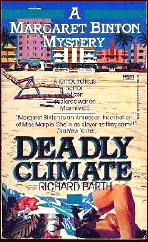
The fifth caper for septuagenarian New Yorker Margaret Binton is Deadly Climate, by Richard Barth. Here Margaret wins a $40,000 RV in a raffle, and she and three friends of comparable vintage head for Miami, where they plan to vacation a bit and sell the vehicle.
On arrival they are rousted from street parking by one of Police Capt. Diamond’s minions. Complaints fall on deaf Diamond ears; he’s more concerned with the cocaine importation industry, flourishing of late. So Margaret and friends turn to good works, giving rides to housebound retirees.
Curiously, the management of Forstman’s Rest Home won’t let its inhabitants out for a ride. Strangely, those inhabitants seem more prisoners than anything else. But of course none of this could put Margaret and cohorts in deadly danger, none of this could have anything to do with cocaine… Of course not.
Very enjoyable fun and games.
— From The MYSTERY FANcier, Vol. 11, No. 2, Spring 1989.
The Margaret Binton series:
The Rag Bag Clan (n.) Dial 1978.
A Ragged Plot (n.) Dial 1981.
One Dollar Death (n.) Dial 1982.
The Condo Kill (n.) Scribner 1985.
Deadly Climate (n.) St. Martin’s 1988.
Blood Doesn’t Tell (n.) St. Martin’s 1989.
Deathics (n.) St. Martin’s 1993.
Sat 25 Sep 2010
Posted by Steve under
ReviewsNo Comments
IT IS PURELY MY OPINION
Reviews by L. J. Roberts
MAGDALEN NABB – The Marshal’s Own Case. Scribner’s, hardcover, July 1990. Penguin, paperback, August 1991. Trade paperback: Soho Crime, September 2008.
Genre: Police procedural. Leading character: Marshal Guarnaccia; 7th in series. Setting: Florence, Italy.
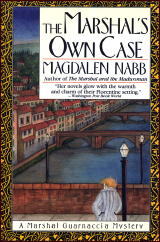
First Sentence: The week that school opens for the autumn term is as bad a Christmas.
An older woman asks the Marshal to look for her 45-year-old son, missing for two weeks and his own son is having problems in school.
When pieces of the son, “Lulu,” turn up in plastic garbage bags, Guarnaccia is assigned to lead the murder investigation. With the assistance of his Captain’s man, Ferrini, the Marshal is introduced to Florence’s transsexual community to find a killer and save an innocent man’s life.
In many ways, this is a book about those on the outside: children teased at school; immigrants whose lives were intolerable in their native lands yet find themselves abused in a place they took refuge; those emotionally abused and those whose sexual preferences do not conform.
Marshal Salvatore Guarnaccia doesn’t feel he fits in; he is big, clumsy, and allergic to the sun, has always been told he is a dreamer and never feels as smart or clever as those around him. He loves his family yet is uncomfortable showing or expressing his emotions. Even Guarnaccia’s Captain views him as “…none too bright and far from articulate but there was no getting away from the fact that he didn’t miss much and that the quieter he got, the nearer he was to whatever he was after.”
It’s nice to have a protagonist who is not handsome and macho, but who has insecurities as we all do. While some may choose not to read this book because of the subject matter, that would be a shame. Ms. Nabb introduces us to a cross-section of the transgender community in a sensitive and non-sensational, non-judgmental manner establishing back stories for each of the characters, individualizing them.
Nabb, once again, takes us to a new area of Florence. Beyond providing a sense of physical place, for part of the book, she takes the weather and makes it an element that is almost another character.
The plot is engrossing, emotional, tragic and poignant. I applaud Nabb for not employing a cliched ending. Each book in this series has, so far, been better than the last. This is no exception. The impact has stayed with me far beyond the final page.
Rating: Excellent.
Sat 25 Sep 2010
REVIEWED BY WALTER ALBERT:
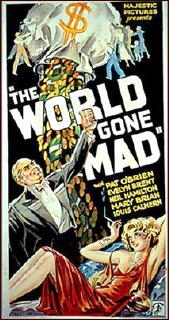
A WORLD GONE MAD. Majestic Pictures/Capitol Film Exchange, 1934. Pat O’Brien, Evelyn Brent, Neil Hamilton, Mary Brian, Louis Calhern, J. Carroll Naish. Screen story: Edward T. Lowe. Director: Christy Cabanne. Shown at Cinevent 42, Columbus OH, May 2010.
The very truncated cast list I’ve provided is only the tip of an iceberg that includes some talented supporting players. [A full accounting can be found on IMDB. Follow the link.]
The program notes point out that while Majestic was a small company that might be classed among the Poverty Row studios, it was among the cream of the minors, able to make use of Universal’s facilities, and, because of a tie-in with Louis B. Mayer’s secretary Ida Koverman, able to draw on MGM technicians like editor Otis Garrett (later director of The Black Doll) and cameraman Ira Morgan.
However, in spite of the connections with Universal and MGM, this played like a Warner Brothers production, with the fast paced script based on contemporary headlines that were often a feature of the WB product.
What also impressed the writer of the program notes (Steve Haynes) was its connection with more recent events, in its portrayal of a pyramid scheme that benefits the men at the top, and milks its investors of their life-long savings.
O’Brien plays a cynical reporter who’s close to both the few good guys and the crooks whose most odious and well-portrayed representative is played by Louis Calhern, while the chief “enforcer,” an assassin for hire, is strikingly played by J. Carrol Naish.
Not a great film, but a very effective and often chilling one, although the effectiveness of at least one major scene is undercut by the unrestored print that allows the scene, meant to be played out in semi-darkness, to be screened in almost total darkness.
Fri 24 Sep 2010
Posted by Steve under
Reviews[7] Comments
Reviewed by MIKE GROST:
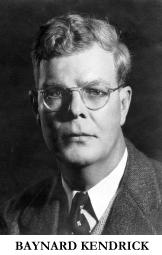
BAYNARD KENDRICK – Make Mine Maclain. William Morrow & Co., hardcover, 1941. No paperback edition.
Make Mine Maclain contains three novellas, all starring blind detective Captain Duncan Maclain. It makes entertaining reading, and is recommended.
1. The Silent Whistle. First publication.
“The Silent Whistle” has a main mystery plot that is somewhat different from Kendrick’s usual approaches. It looks at a nocturnal errand done by the victim, and keeps imagining different explanations of what happened on the errand. These explanations are not masterpieces, but they offer solid ingenuity.
The structure of this main story in “The Silent Whistle” anticipates that of Kendrick’s “5 – 4 = Murderer” (1953):
â— Both open with Maclain at a remote location, where he has journeyed to assist a friend.
â— Both have Maclain exploring by himself what turns out to be a murder scene.
â— Both of these sequences are eerily atmospheric; both also are from Maclain’s Point of View, showing how they appear to his senses such as hearing or touch.
â— Both tales eventually offer multiple, alternative explanations to their main events.
“The Silent Whistle” does have some subplot puzzles that are regular Kendrick specialities:
â— One about dogs and dog whistles, is a Kendrick animal puzzle.
â— The killer manipulates the victim’s behavior through lying phone calls: a variation on the Kendrick standard where the murderer does this through written notes.
â— An alibi subplot is something of a tired old wheeze, used many times before Kendrick.
Elements of the background recall Erle Stanley Gardner:
â— The tale takes place not in Kendrick’s usual New York City, but in the small Southern California towns often used by Gardner.
â— The mystery elements involve driving around S. California: also a frequent source of Gardner puzzles.
â— The victim’s errand involves a complex financial transaction: something Gardner often included to thicken the plot, in his legal mysteries.
â— A lawyer is a character.
The financial transaction has political aspects that I have never seen in any other book, mystery or general.
The trap set by the killer at the end, recalls a bit the one in Cornell Woolrich’s “The Room with Something Wrong” (1938).
2. Melody in Death. First published in The American Magazine, June 1945.
“Melody in Death” (1945) is a not-very-good novella about an opera company, suffering from both dull storytelling and a lack of mystery puzzle ingenuity.
The best mystery subplot involves the song. This is an example of the messages that run through Kendrick. Like others, this one is close to a Dying Message. What it leads to or indicates is also clever. This whole subplot is resolved halfway through the novella.
Kendrick tries for one of his puzzles, where the killer is indicated by being the only person with access to knowledge. Unfortunately, this subplot is a botch. The reasoning is far-fetched. It also has flaws (the victim could have been spreading the information right and left through phone calls, for example).
The basic construction of this puzzle is different from typical in Kendrick. In “Melody in Death,” the claim is that the killer could only have learned something from the victim, just before he killed her, and hence is the murderer: the period just before death was the only time of possible contact between victim and the alleged killer.
If he hadn’t killed her, there would have been no other contact, and he would not have known this information. By contrast, in most Kendrick, there is a piece of general knowledge, shown to have been possessed by whoever did the murder, and it turns out that only one person had the necessary access to the information.
The construction of the puzzle in “Melody in Death” is interesting. One only wishes it had been executed a little better.
There is a suspense finale, something common in Kendrick. This one involves mechanical aspects of an opera house, recalling a bit the mechanical aspects of a hotel building used in the nice finale of The Whistling Hangman. This finale is the second-most-decent feature of “Melody in Death”.
Earlier, the region under the opera stage is discussed, reflecting Kendrick’s interest in underground regions. However, the action of the novella never actually goes under the stage.
3. The Murderer Who Wanted More. First appeared in The American Magazine, January 1944 .
“The Murderer Who Wanted More” is mainly a suspenseful tale about a “woman in jeopardy”. It has a simple whodunit plot, with a solution whose cluing seems to depend entirely on a dubious motive.
Despite its limitations as a detective puzzle, it is a good piece of story telling. The opening suspense sequence, showing a journey taken by the heroine, is especially well done. Most of the rest of the story takes place in the real town of Tottenville, Staten Island, New York.
The tale shows Kendrick’s skill at scene painting. Blind Man’s Bluff, published the previous year, also opens with a woman making a spooky journey in New York City at night.
The opening journey recalls the long trips in Blood on Lake Louisa. Like them, the journey leads to a discussion of alibis and alternate routes. In both works, this likely reflects the influence of Freeman Wills Crofts.
There is a pleasant contrast in the two works: Blood on Lake Louisa takes place in the warmth of Florida, “The Murderer Who Wanted More” in Staten Island during a winter snow storm. (A journey on the Staten Island ferry also occurs in Frank Sullivan’s comedy gem found in his collection of comic sketches A Pearl in Every Oyster (1938).)
A subplot about the mysterious man in the black overcoat, is simple, but also a nice mystery element. It eventually leads to a plot idea about the background of the man, a Kendrick specialty. Kendrick’s description of the man stresses the elegance of the belted overcoat. Overcoats were among the most festive and swaggering elements of men’s fashion in that era.
The sinister past of Staten Island in Colonial days is discussed. A liberal critique of slavery in that era is brought in. The same year, Dragonwyck (1944), an historical novel by Anya Seton, would look at the sinister anti-democratic regimes of Old New York. The Balcony (1940), a mystery novel by Dorothy Cameron Disney, also looks back at the legacy of slavery.
A good guy character is a Certified Public Accountant in New York. This recalls the interest in finance in Blind Man’s Bluff. We also get a look at financial deals behind World War II war industry work.
Thu 23 Sep 2010
Reviewed by DAVID L. VINEYARD:
SEVEN SINNERS. Gaumont British Pictures, 1936. Released in the US as Doomed Cargo. Edmund Lowe, Constance Cummings, Thomy Bourdelle, Henry Oscar, Joyce Kennedy, Felix Aylmer. Screenplay by Sidney Gilliat & Frank Launder; story by Arthur Ridley & Bernard Merivale based on the play and novelization The Wrecker by Arthur Ridley. Director: Albert de Courville.
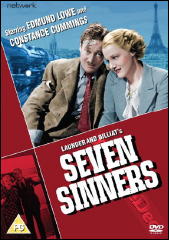
Edward Harwood (Edmund Lowe): First I meet a dead man who’s alive and then I meet a living man who’s dead.
Tankerton Agency detective Edward Harwood stumbles on a body in his hotel room in Nice during Carnival and as quickly loses it, and Caryl Fenton (Constance Cummings) the insurance agent sent to fetch him to Scotland to solve a case of missing jewelry is convinced it’s all part of an alcoholic haze, and hustles him off to Scotland.
Until they are both victims of a train wreck on the Riviera Express where the corpse Harwood lost shows up as one of the hundreds of victims.
Learning from M. Turre, the Assistant Prefect of Police, that the wreck was deliberate Harwood and a reluctant Fenton are off to Paris and a trail that leads from an elegant Paris flat to London’s Guild Hall; to a small village in the West of England; to a man who died three years earlier but who they just met in Paris; to another train wreck to silence a doctor who falsified a death certificate; to the Pilgrims of Peace and a phony charity; and to a deadly confrontation on a train to Southampton where the Wrecker is determined to silence anyone who might lead to him — including Harwood and Fenton.
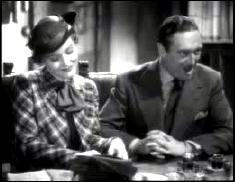
It should come as no surprise if this fast paced thriller reminds you of some of Hitchcock’s thrillers of the period, such as The Thirty Nine Steps and The Lady Vanishes, since screenwriters Sidney Gilliat and Frank Launder would go on to write and direct some of the best British films of all time.
Among them, and rivaling Hitchcock in popularity and skills, are Green for Danger, State Secret (The Great Manhunt), The Lady Vanishes (with Alma Reville, directed by Hitchcock), The Green Man, She Played With Fire, Waterloo Road, and Belles of St. Trinian’s. Their last film was Agatha Christie’s Endless Night with Haley Mills and George Sanders in 1972.
Seven Sinners, also known as Doomed Cargo when released in the US, is a fast paced, clever, and witty thriller with echoes of The Thin Man and first rate performances by Lowe and Cummngs.
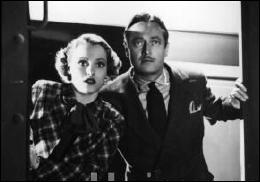
The film is based on the story (co-written with Bernard Merrivale), play, and novelization of The Wrecker by Arthur Ridley, a popular “barn burner” as such plays were known. Ridley specialized in these, also writing Ghost Train, another “barn burner” that became a hit film and was also novelized by Ridley (remade as the hilarious Runaway Bus with Margaret Rutherford).
Edmund Lowe seemed to specialize in detective roles, playing Nick Carter, Philo Vance, Lawrence Blochman’s Inspector Prike (changed to Dyke in Bombay Mail), and Chandu the Magician, starting in films in 1915 and ending with George Cukor’s Heller in Pink Tights in 1960. Along the way he was Captain Quirt in What Price Glory?, his biggest role, and appeared in such films as Dinner at Eight, The Last Hurrah, The Great Impersonation, Dillinger, and Mister Dynamite. He was sleuth/reporter David Case on early television’s Front Page Detective.
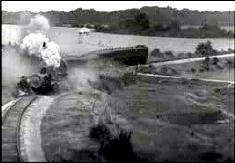
Constance Cummings played Harriet Vane opposite Robert Montgomery’s Lord Peter in Haunted Honeymoon, but fared much better in this and Blithe Spirit with Rex Harrison and Kay Hammond. Her scenes with Lowe have real crackle and snap to them, with a slight hint of the American screwball school well played by both actors.
Albert de Courville was a successful director and producer (probably best known on this blog as the producer of The Shanghai Gesture). [Reviewed here. ]
The train wrecks are well staged, and while there is some obvious model work and rear projection, they were state of the art at the time, and you can imagine the final train wreck with the train boring down head on had audiences jumping in the theaters of the time. It’s still pretty exciting stuff.
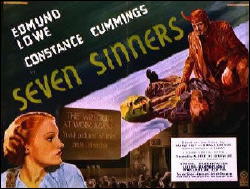
The finale, a shoot out in a movie theater during a newsreel about the Wrecker, likely inspired the similar scenes in Hitchcock’s Saboteur and John Huston’s Across the Pacific. If it doesn’t exactly make a lot of sense it’s a well done set piece and a fitting ironic end as the Wrecker meets his fate while the newsreel announcer asks “Where is the Wrecker?”.
One word of warning. When you are looking for this you are going to encounter the 1940 Tay Garnett John Wayne/Marlene Dietrich film Seven Sinners more often than this one. It’s a good film too, but nothing to do with this.
The title refers to the conspirators in the scheme and the Wrecker himself, if you come up one short, listen carefully and you’ll discover there was an off screen murder and train wreck they mention that happens before the point where the film starts.
Highest recommendations for this first rate comedy mystery. This is how it should be done, smart, witty, and moving at a gallop. Luckily the print available is very good despite being on the “gray” market and you can enjoy it in all its glory.
See it. It’s well worth the effort.
Thu 23 Sep 2010
THIS IS A THRILLER
by Walker Martin
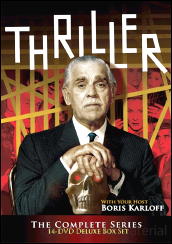
We all remember the golden age of fantasy, SF, and horror television. Anthology series such as Twilight Zone, Outer Limits, Night Gallery, Alfred Hitchcock Presents, One Step Beyond. One of the very best was Thriller, hosted by Boris Karloff and lasting 67 hourly episodes during 1960-1962.
I was just a teenager at the time but I still remember skipping dates and not watching Phillies baseball, just in order to not miss the show. A few years ago I managed to track down a bootleg set of all the episodes on DVD, and I relived the joy of watching this great black and white spooky series.
Somehow I had forgotten just how bland and mediocre some of the crime and mystery episodes were. All I had remembered were the great horror stories like “Pigeons from Hell,” “The Grim Reaper,” “The Cheaters,” “The Hungry Glass,” and others.
After watching a dozen or so of the early crime episodes I was beginning to think that my memory was playing tricks on me and that the horror shows were from some other show.
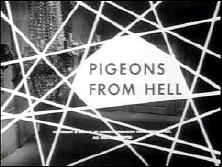
Then I got smart and started skipping around and watching the episodes out of order, especially paying attention to the eighteen episodes adapted from Weird Tales, that great pulp of the supernatural. Yes, you read right, I said eighteen of the stories are from Weird Tales!
After watching these eighteen shows and other horror adaptations from various sources, I was able to even enjoy some of the crime and mystery plots, though in my opinion they could not begin to compare with the horror episodes.
Frankly, I never figured the entire series would see an official DVD release but I am glad to say that I was mistaken. Image Entertainment recently released a box set containing all 67 shows and included such extras as over two dozen audio commentaries, mainly on the horror episodes, isolated music scores, episode promos, an so on.
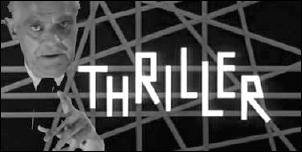
Since I had viewed all 67 shows just a few years ago, my intent initially was to only watch the horror stories again, and listen to the commentaries. But fate stepped in and I stumbled across an announcement that Pete Enfantino and John Scoleri would be hosting a discussion on Thriller by way of a blog.
Comments are welcome and each day a different show is covered, starting from the first and continuing to the 67th and last one. There are also breaks for interviews and topics like “The Girls of Thriller”. Each show is rated by a system of “Karloffs” from zero to 4 Karloffs.
I am happy to say that this discussion has become part of my daily viewing. Each day I watch an episode and then look at the blog to read about what Pete and John have to say.
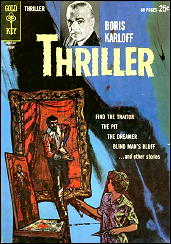
They are only on the 17th episode as I write this, and now would be a good time to dive in and join the fun. Especially since the horror episodes are starting to be discussed and you can skip some of the bland, more mundane crime shows. Or you can watch them also and then read what they have to say, and what they say is always done with wit and humor.
The discussion takes place at www.athrilleraday.blogspot.com and gets my highest recommendation. It’s a lot of fun talking about the old Thriller shows, and comments are encouraged.
By the way, the Thriller box set has a list price of $150 but is heavily discounted at the online stores. For instance I paid only $97 from Amazon. Even though I already had a bootleg set, I consider this “official” release money well spent.
Wed 22 Sep 2010
A 1001 MIDNIGHTS Review
by Bill Pronzini:
ANTHONY WYNNE – The Case of the Gold Coins. J. B. Lippincott, US, hardcover, 1934. Reprint: A. L. Burt, hardcover, no date. UK edition: Hutchinson, hardcover, 1933.
Anthony Wynne (Robert McNair Wilson) was one of the lesser Golden Age writers — the creator of Dr. Eustace Hailey, a Harley Street specialist in mental disease who once offered the following opinion: “The really interesting crimes are those … in which the method employed, as well as the motive, constitutes a puzzle.”
Method is indeed the most interesting element in Wynne’s mysteries: No less than sixteen of his twenty-eight novels feature an “impossible crime” of one type or another (most often the use of an “invisible agency” to murder someone in closed or guarded surroundings). Some of his “impossibles” are quite ingenious — The Case of the Gold Coins, for instance.
In this case Hailey’s assistance is solicited by Captain Jack Ainger of the CID to investigate the strange death of Lord Wallace in a remote section of Northumberland. Wallace’s body was found in the middle of a wide expanse of beach near his home, badly battered and bruised, with a knife driven into his back.
The location of the wound and bloodstains found under the corpse prove that he died on the spot. Yet there are no footprints in the sand for many yards in any direction and no way either the murderer or the sea could have erased any. A thrown knife is out; that still wouldn’t explain the absence of footprints.
Also out are the possibilities of the body having been dropped from an airplane or hurled by a catapult or by bodily force.
Dr. Hailey sets about questioning the suspects: Lady Wallace, the sister-in-law of the murdered man; Ruth Wallace, the lord’s niece; Colonel Bolton, a neighbor and old enemy of Wallace’s; the colonel’s daughter, Pamela; Wallace’s solicitor, Giles; and one of the local squires, Peter Ingram, who was engaged to Ruth but is now in love with Pamela.
Don’t be misled, though: This is no actionless house-party drama; there is a good deal of skulking around in the night, two more murders, a couple of close shaves for Dr. Hailey (one of which involves sailboats and an unexpected predawn swim), eerie doings on a little offshore island, more intrigue centered on an old flour mill near the Wallace estate, and a hidden treasure of gold sovereigns.
All the elements are here for a dandy novel. Unfortunately, Wynne’s handling of them results in “rather heavy melodrama,” as Howard Haycraft termed his work. Wynne wrote well, but in a solemn, reserved, curiously detached manner, as if he were unable to involve himself in his narrative.
And Hailey is something of a colorless and plodding sleuth, whose only distinct character traits are taking snuff and “drawing his hand across his brow,” both of which he does constantly.
Still, the explanation of how Lord Wallace was murdered is worthy of John Dickson Carr — although one facet of it is a little hard to swallow — and alone makes the novel worth reading.
The same is true of such other Hailey investigations as The Green Knife (1932), in which there are three locked-room murders by stabbing; The Toll House Mystery (1935), in which a murdered man is found shut up alone in a closed car surrounded by untrodden snow; and Emergency Exit (1941), about a stabbing in an air-raid shelter surrounded by unmarked snow.
Also interesting is the lone Dr. Hailey short-story collection, Sinners Go Secretly (1927), which contains two “impossibles.” If you enjoy this type of mystery, don’t pass these up. Despite their flaws, Wynne’s puzzles will keep you guessing and absorbed throughout.
———
Reprinted with permission from 1001 Midnights, edited by Bill Pronzini & Marcia Muller and published by The Battered Silicon Dispatch Box, 2007. Copyright © 1986, 2007 by the Pronzini-Muller Family Trust.
Wed 22 Sep 2010
Posted by Steve under
Reviews[10] Comments
A REVIEW BY CURT J. EVANS:
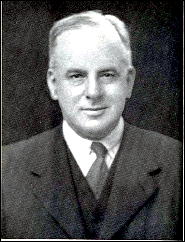
ANTHONY WYNNE – Murder of a Lady. Hutchinson, UK, hardcover, 1931; Crime-Book Society #44, paperback, 1930s. US title: The Silver Scale Mystery, J. B. Lippincott, hardcover, 1931.
Scottish-born physician Robert McNair Wilson (1882-1963) was a man of many interests. Besides practicing medicine, he wrote about numerous subjects, including European history, economics (his economic thought influenced the famous poet and fascist Ezra Pound and continues to attract interest at certain quarters of the internet).
More importantly, under the pseudonym Anthony Wynne, he wrote a series of twenty-seven detective novels between the years 1925 and 1950. This is the work, of course, that interests us most here at the Mystery*File blog.
Anthony Wynne’s detective novels have been out of print for sixty years, but some retain interest today. Along with John Dickson Carr, Wynne was one of the most prominent Golden Age practitioners of the locked room mystery. Unfortunately, his novels often tend to be overly melodramatic, thinly characterized and humorless, no doubt in part explaining their obscurity today.
One of the best Anthony Wynne detective novels, Murder of a Lady (The Silver Scale Mystery in the United States), deserves reprinting, however. Set in Scotland, where Wynne himself grew into adulthood, Murder of a Lady benefits from strong atmosphere (with supernatural overtones), some compelling characters and emotional entanglements, a baffling and suspenseful problem and a plausible enough solution.
The “Lady” in question, Mary Gregor, sister of a laird, is found dead by violence in her bedroom in her brother’s Highland Scottish castle. The author offers a classic sealed room situation, with locked doors and windows. More deaths occur, all seemingly impossible.
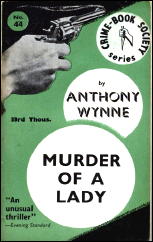
“The assassin kills but remains invisible,” announces nerve specialist Dr. Eustace Hailey, Wynne’s snuff-taking but not especially interesting series detective. In each case a herring scale is found on the victims body, a detail leading to suspicions among the superstitious locals (which includes gentry as well as plain folk) that legendary fish creatures from the nearby waters are responsible the mayhem, taking vengeance for past family misdeeds.
The crimes are truly baffling, and suspense during the investigations of both Dr. Hailey and the professionals is well maintained. The Scottish Highland atmosphere, with its supernatural elements, is very well done. (I couldn’t help but be reminded of John Dickson Carr’s The Case of the Constant Suicides, thought the humor in that book is utterly absent from Wynne’s.)
The household of the laird and his sister — which includes a son and daughter-in-law and several servants — is strongly drawn as well. Particularly admirable is the author’s delineation of the character of the first murder victim (the lady), who dominates the household even in death, a defunct spider whose victims still struggle in the remains of her web.
I was kept in suspense until the author sprang his solution, and Dr. Hailey’s explanation maintains interest until the very last paragraph of the novel, when we learn the true meaning of one element of the mystery.
Murder of a Lady is Golden Age detective fiction at its considerable best. I’m going to talk to Ramble House about getting this one reprinted.
« Previous Page — Next Page »








